The Milk Street Jewish Ritual Bath or mikveh: the most culturally significant structure found on an archaeological excavation in the City of London
Ian Blair
With the excavation of the massive Roman wells and their bucket chains completed on 20-30 Gresham Street, I found myself working with a small team of archaeologists through the summer months in the Stygian gloom of the basement and former gold bullion vault of the State Bank of India at 1-6 Milk Street, on the west edge of the site.
The footprint of the basement encompassed the earlier DUA Milk Street (MLK76) excavation.
An unusual feature that started to emerge close to the Milk Street frontage during our initial hand-clearance of the basement which clearly had not been exposed in the earlier excavation, was a well-constructed masonry structure lined with faced greensand ashlar blocks. The structure was aligned roughly north-south and was ultimately found to consist of a minimum of seven steps leading down from the north into an enclosed apsidal ended chamber. The overall internal dimensions of the structure measured 3.00m x 1.20m, and the maximum internal depth was 1.45m.
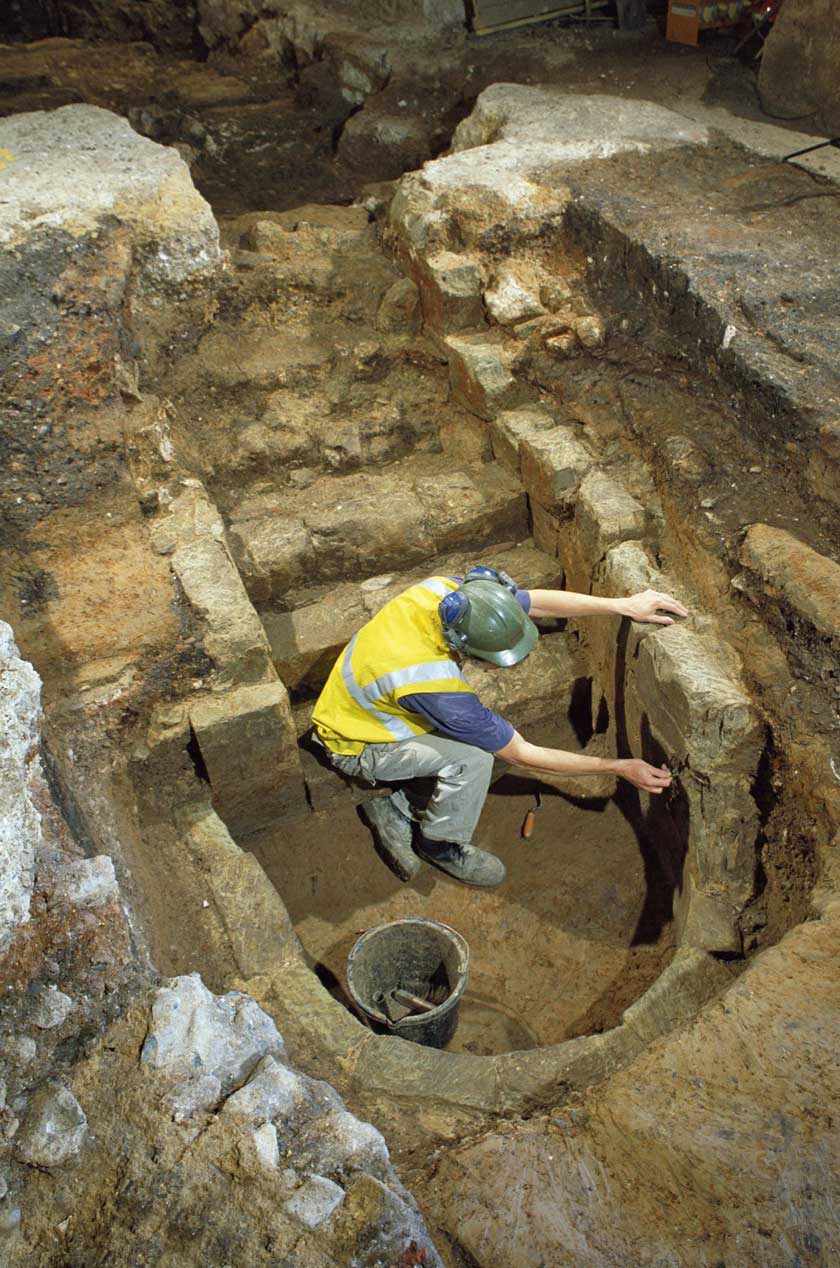 The Milk Street mikveh showing the full extent of the original structure, with Ian Blair (looking north)
The Milk Street mikveh showing the full extent of the original structure, with Ian Blair (looking north)
Photo by permission: MOLA ©MOLA Photographer Andy Chopping
Its unusual form immediately suggested the possibility of it being a Jewish Ritual Bath or mikveh, but one of a more elaborate form to that found by Ken Steadman in 1986 on the nearby Guildhall House, 81-7 Gresham Street (GDH85) site. When first discovered this rectangular structure had been interpreted as a small subterranean strong-room but was later reinterpreted as a mikveh by Richard Sermon in 1990. 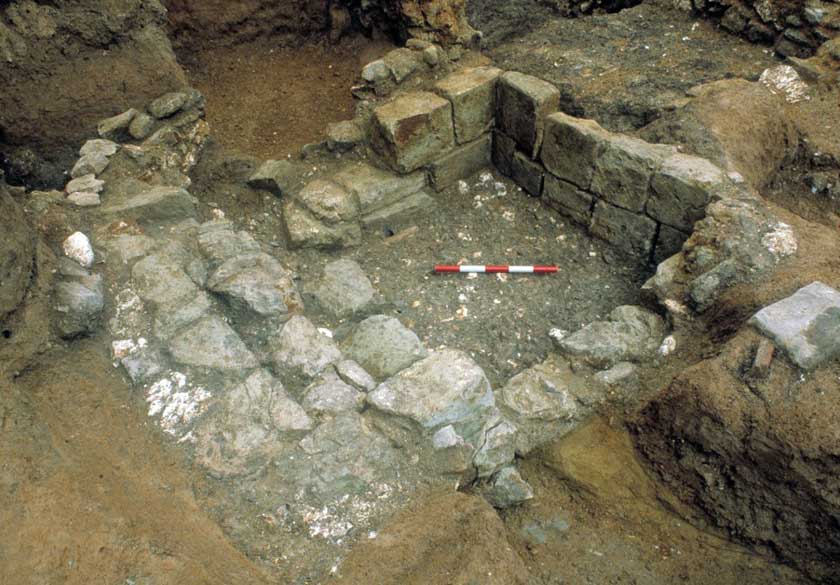 View of the 81-7 Gresham Street mikveh discovered in 1986 (looking north-east)
View of the 81-7 Gresham Street mikveh discovered in 1986 (looking north-east)
Photo by permission: MOLA ©MOLA Photographer Maggie Cox
The uppermost four steps leading down into the newly discovered Milk Street mikveh had been substantially robbed, although their original profile could be discerned where they had been broken off in the face of the east wall. The fill behind one of the steps and the infill behind the lining produced small assemblages of London and Kingston ware pottery providing a mid-thirteenth century construction date for the structure. The Stonework of the open apsidal ‘bath’ was finely carved with very narrow and tight-fitting joints between the individual ashlar blocks to make the structure watertight. It is assumed that the absence of a stone slab or tile floor in the base of the bath, was simply because these elements, like some of the upper walls of the structure, had later been robbed.
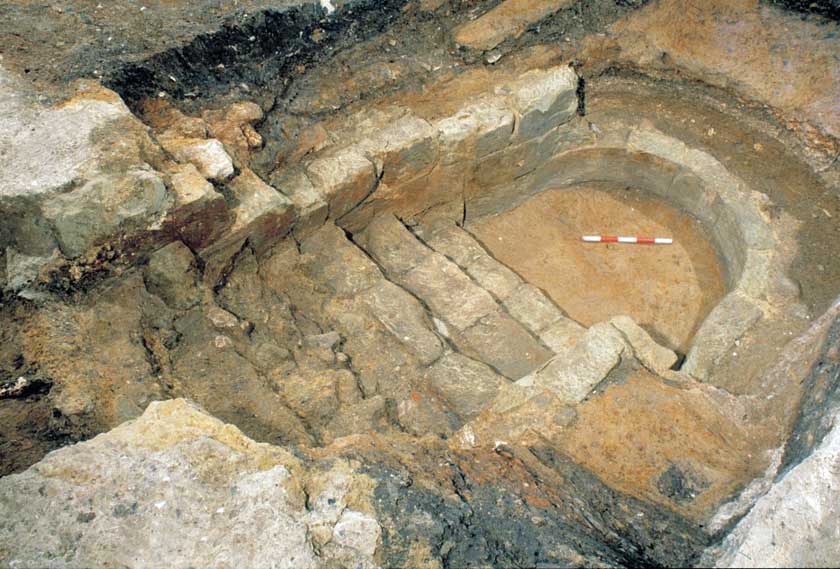 The Milk Street mikveh looking down the steps into the apsidal bath (looking south-east)
The Milk Street mikveh looking down the steps into the apsidal bath (looking south-east)
Photo by permission: MOLA ©MOLA Photographer Maggie Cox
The mikveh was later modified by the addition of a crudely built east-west internal blocking wall composed of irregular blocks of reused greensand. The wall was built directly onto the lowest three steps and was butted against the walls flanking the stairs. Although the addition of this wall effectively closed off the open end of the apsidal bath from the stairway, it is uncertain if it was a deliberate modification to deepen the bath during its functioning life. Although it would have had merits in greatly reducing the amount of water required to allow full immersion in the mikveh, which in its original form would have necessitated between four and six of the steps into the structure to also be submerged.
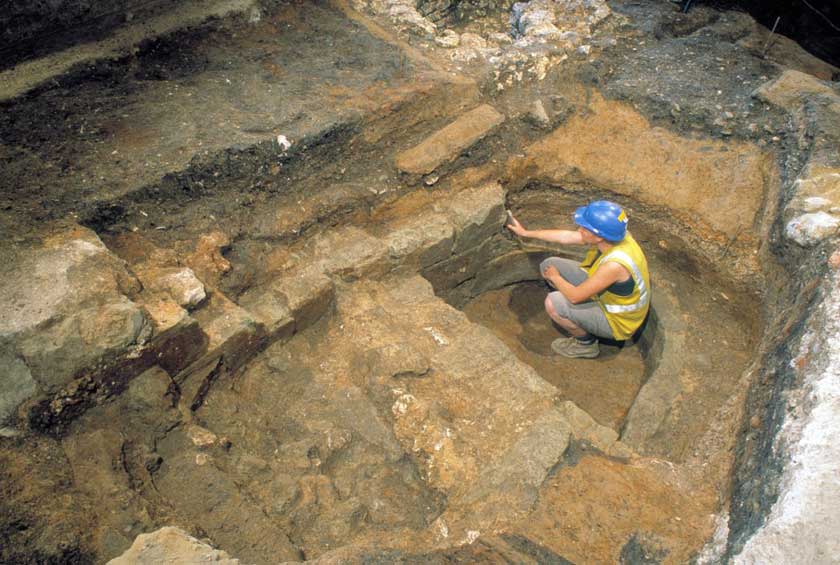 The Milk Street mikveh with the secondary blocking wall in place, effectively isolating the apsidal ended bath from the stairway, with Catherine Edwards (looking south-east)
The Milk Street mikveh with the secondary blocking wall in place, effectively isolating the apsidal ended bath from the stairway, with Catherine Edwards (looking south-east)
Photo by permission: MOLA ©MOLA Photographer Maggie Cox The mikveh was abandoned following the expulsion of the Jewish community from England by Edward 1 in 1290. At that time, the Milk Street property was occupied by a Jew, Moses Crespin, who had inherited it from his father Jacob. The Crespins were leading London financiers. Jews were not permitted to resettle legally in England again until 1656. The mikveh is the only identifiable monument that has survived from the Jewish community of medieval London and as such is arguably the most culturally significant structure found on an archaeological excavation in the City of London.
The discovery of the mikveh caused tremendous excitement in Jewish communities in London and further afield and the comments made by visitors of the Jewish community to the mikveh during its excavation made a lasting impression on all concerned. Almost all the family of one elderly, blind visitor had perished in the Holocaust. She described how a great sense of loss had stayed with her ever since, making every fragment of her heritage even more precious. Her donation was one of many from the Jewish community which paid for the dismantling of the mikveh.
By the time the mikveh was discovered on the Gresham Street site the film crew who had followed the earlier phases of the excavation for the Time Team Special: ‘Londinium: Edge of Empire’, had completed their filming and departed. Determined to have a film record of this important structure we contacted the assistant producer Nick Powell who kindly brought his small hand-held video camera to the site. The resultant short film recorded in the poorly-lit and noisy basement, is composed of a series of clips spliced together and has a simple charm and beauty to it.
The film captured a key moment when leading Jewish scholars, including Dayan Chanoch Ehrentreu (Head of the Court of the Chief Rabbi), visited to view the structure and determine if it was a mikveh: a ritual bath used as a form of spiritual cleansing at various points in Jewish life, which after careful deliberation they confirmed to be genuine.
Watching the video again I could not help but be as moved as I had been over two decades ago when I was witness to the site visit, in the certain knowledge that we had discovered something of incalculable historical and cultural importance, facilitating the repatriation of a lost Jewish monument when those present were able to walk down the steps into the mikveh, over seven hundred years after members of London’s medieval Jewish community had last done so.
Acknowledgments
Thanks to funding from the congregation of the Bevis Marks Synagogue, the mikveh was carefully and systematically dismantled so it could be rebuilt in a suitable setting. The mikveh was stored at the London Archaeological Archive and Research Centre (LAARC) for several years, before being installed in the new extension of the Jewish Museum in Camden Town in March 2010.
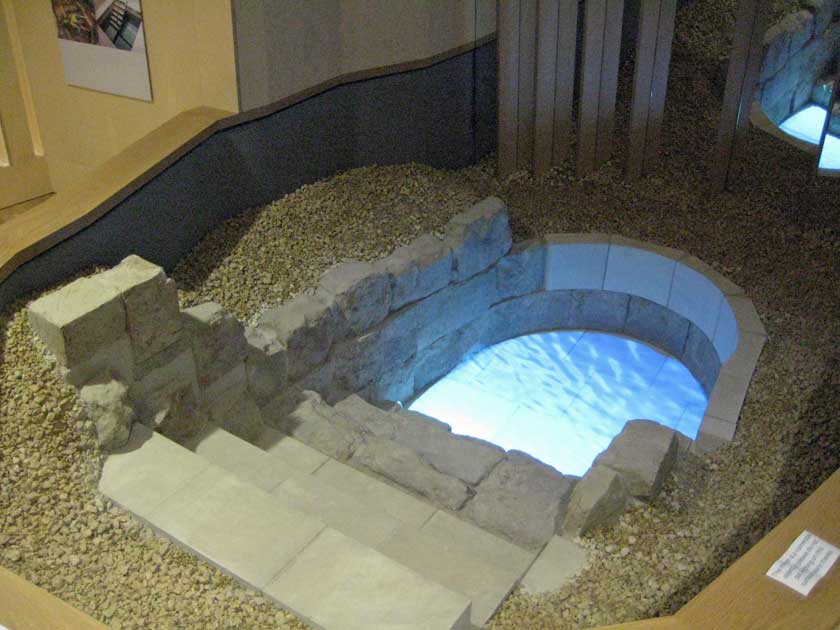 The mikveh as reconstructed at the Jewish Museum in Camden Town, complete with shimmering water effects
The mikveh as reconstructed at the Jewish Museum in Camden Town, complete with shimmering water effects
Photo by Ian Blair
Special thanks are due to Nick Clarke Powell for giving us permission to use his short film which accompanies this piece.

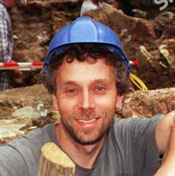

Comments powered by CComment